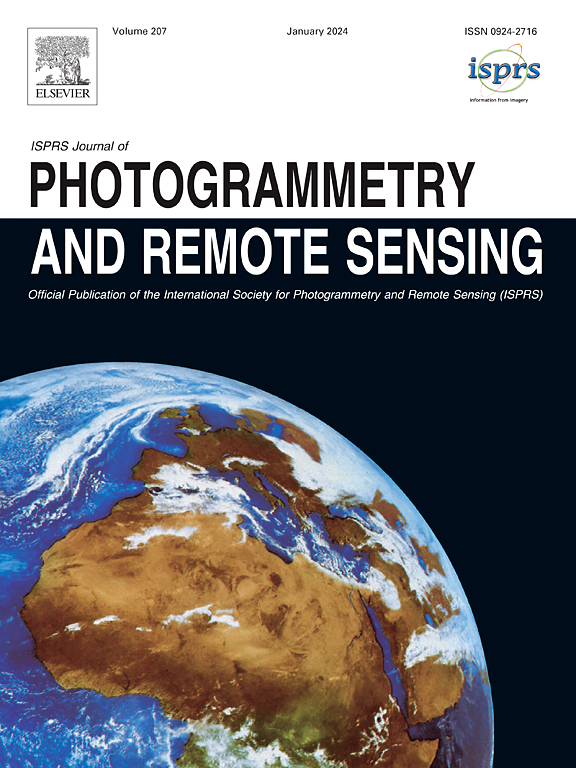CPVF: vectorization of agricultural cultivation field parcels via a boundary–parcel multi-task learning network in ultra-high-resolution remote sensing images
IF 10.6
1区 地球科学
Q1 GEOGRAPHY, PHYSICAL
ISPRS Journal of Photogrammetry and Remote Sensing
Pub Date : 2025-05-26
DOI:10.1016/j.isprsjprs.2025.05.019
引用次数: 0
Abstract
Accurate recognition and vectorization of agricultural cultivation field parcels (CFP) are crucial for agricultural monitoring. However, the diverse sizes and shapes of parcels, inherent blurriness of boundaries, and adhesion of densely distributed parcels pose considerable challenges in extracting complete and separable parcels from high-resolution imagery. To address these issues, we propose an end-to-end cultivated parcel vectorization framework (CPVF) based on a boundary-parcel multi-task learning model. The CPVF comprises two components: the model introduced in this paper for CFP extraction, termed the drone-based cultivation parcel extraction multitask learning model (DCP-MTL), and the universal vectorization module (UVM) for post-processing. The model combines region, boundary, and distance tasks with a discrete cosine transform module for frequency domain feature extraction and an ensemble decoding block. The ensemble decoding block with deep-supervision, enhancing parcel region separability and boundary connectivity in complex and densely packed parcel scenarios. The UVM incorporates region–boundary interaction and topological relation-based hanging line extension to repair broken boundaries. Experiments on a newly developed the first large-scale ultra-high-resolution (UHR) dataset show that our method achieves a region IoU of 92.88 %, boundary IoU of 60.94 %, and over-segmentation and under-segmentation rates of 17.5 % and 20.7 %, respectively. The proposed method outperforms BsiNet by improving region and boundary IoU by 9.08 % and 20.6 %, respectively, and reducing over- and under-segmentation by 5.7 % and 7 %. We assessed the model’s transferability across ten regions and various farmland landscapes, demonstrating stable generalization. Ablation studies and comparisons confirmed that CPVF provides precise and effective CFP vectorization in diverse and complex farmland scenarios.
CPVF:基于边界-地块多任务学习网络的超高分辨率遥感影像农业耕地地块矢量化
农业种植地块的准确识别和矢量化是农业监测的关键。然而,包裹的大小和形状各异,边界固有的模糊性以及密集分布的包裹的粘附性给从高分辨率图像中提取完整和可分离的包裹带来了相当大的挑战。为了解决这些问题,我们提出了一个基于边界-包裹多任务学习模型的端到端培养包裹矢量化框架(CPVF)。CPVF由两部分组成:本文介绍的CFP提取模型,称为基于无人机的种植包裹提取多任务学习模型(DCP-MTL),以及用于后处理的通用矢量化模块(UVM)。该模型将区域、边界和距离任务与用于频域特征提取的离散余弦变换模块和集成解码块相结合。具有深度监督的集成解码块,增强了复杂、密集包裹场景下包裹区域的可分离性和边界连通性。UVM结合了区域边界交互和基于拓扑关系的悬挂线扩展来修复破碎的边界。在新开发的第一个大规模超高分辨率(UHR)数据集上的实验表明,该方法的区域IoU为92.88%,边界IoU为60.94%,过分割率为17.5%,欠分割率为20.7%。该方法将区域和边界IoU分别提高了9.08%和20.6%,将过度分割和欠分割分别减少了5.7%和7%,优于BsiNet。我们评估了该模型在10个地区和不同农田景观之间的可转移性,显示出稳定的推广效果。消融研究和比较证实,CPVF在多种复杂农田情景下提供了精确有效的CFP矢量化。
本文章由计算机程序翻译,如有差异,请以英文原文为准。
求助全文
约1分钟内获得全文
求助全文
来源期刊

ISPRS Journal of Photogrammetry and Remote Sensing
工程技术-成像科学与照相技术
CiteScore
21.00
自引率
6.30%
发文量
273
审稿时长
40 days
期刊介绍:
The ISPRS Journal of Photogrammetry and Remote Sensing (P&RS) serves as the official journal of the International Society for Photogrammetry and Remote Sensing (ISPRS). It acts as a platform for scientists and professionals worldwide who are involved in various disciplines that utilize photogrammetry, remote sensing, spatial information systems, computer vision, and related fields. The journal aims to facilitate communication and dissemination of advancements in these disciplines, while also acting as a comprehensive source of reference and archive.
P&RS endeavors to publish high-quality, peer-reviewed research papers that are preferably original and have not been published before. These papers can cover scientific/research, technological development, or application/practical aspects. Additionally, the journal welcomes papers that are based on presentations from ISPRS meetings, as long as they are considered significant contributions to the aforementioned fields.
In particular, P&RS encourages the submission of papers that are of broad scientific interest, showcase innovative applications (especially in emerging fields), have an interdisciplinary focus, discuss topics that have received limited attention in P&RS or related journals, or explore new directions in scientific or professional realms. It is preferred that theoretical papers include practical applications, while papers focusing on systems and applications should include a theoretical background.
 求助内容:
求助内容: 应助结果提醒方式:
应助结果提醒方式:


